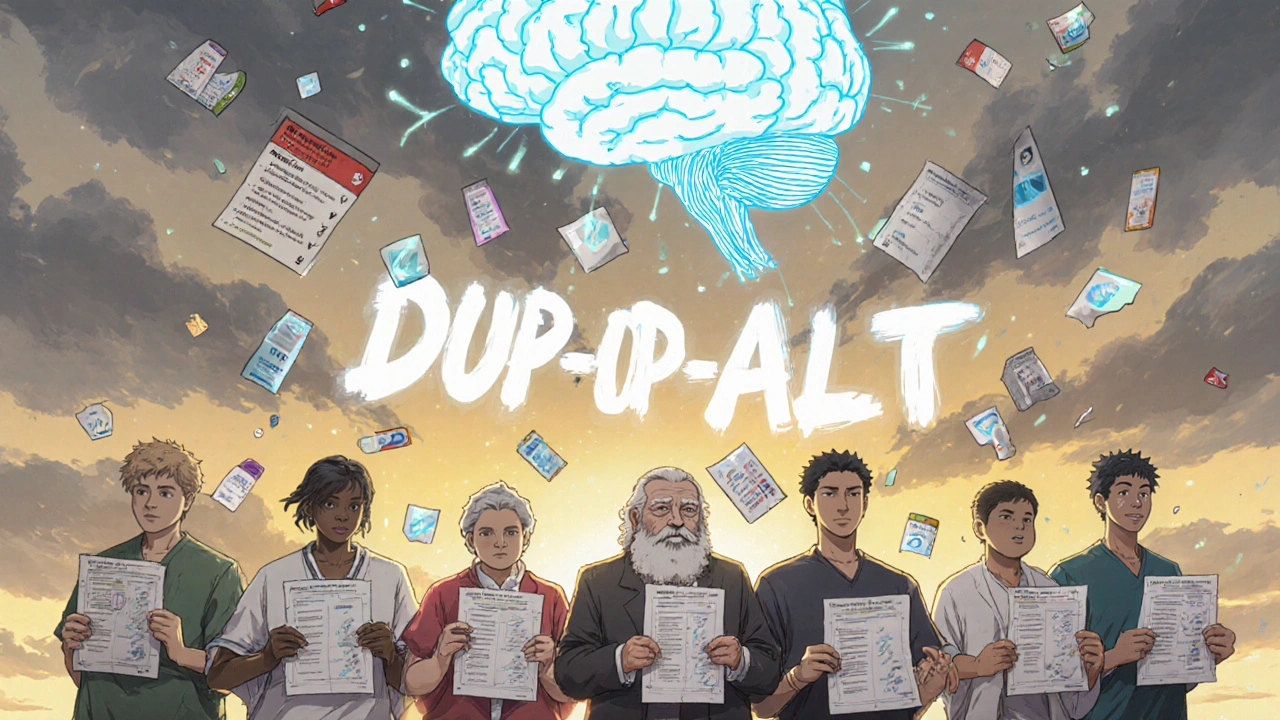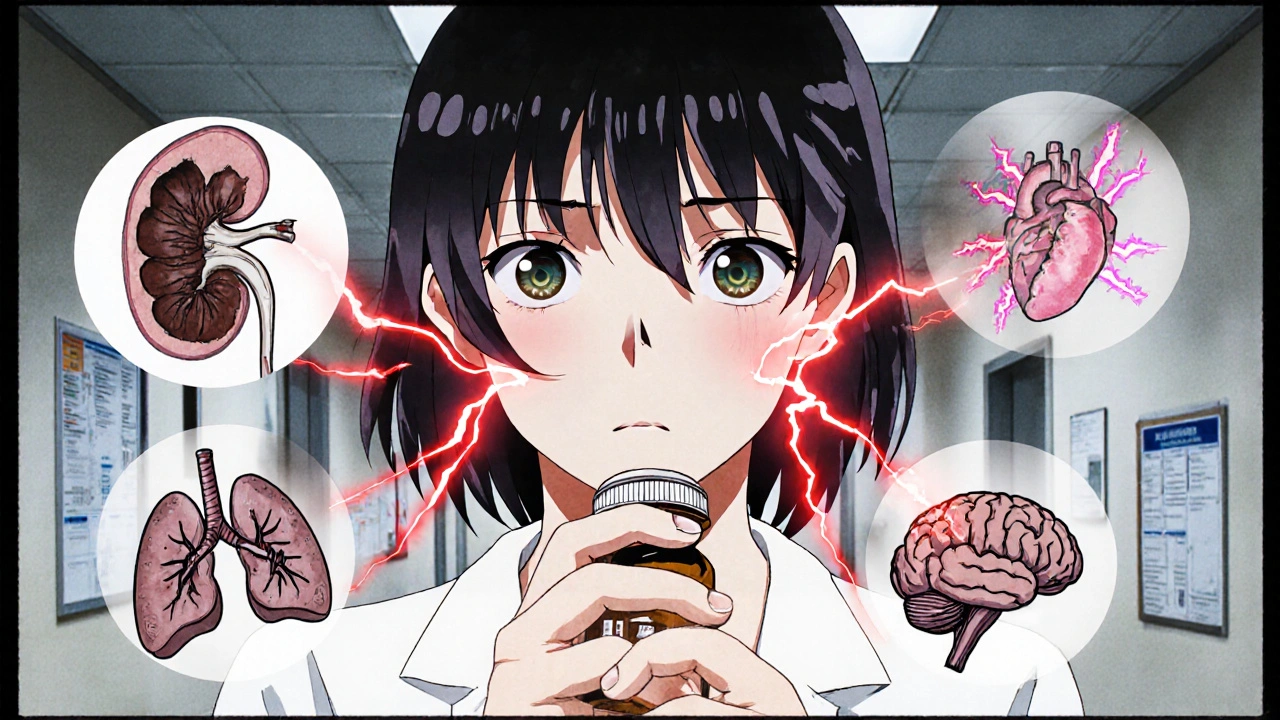Most people know that mixing two pills can cause problems. But what if it’s not the pills you’re mixing-it’s your health conditions? A drug that’s perfectly safe for one person can turn dangerous for another, not because of another medication, but because of an existing disease. This is called a drug-disease interaction-and it’s one of the most overlooked dangers in modern medicine.
What Exactly Is a Drug-Disease Interaction?
A drug-disease interaction happens when a medication meant to treat one condition makes another condition worse-or stops working properly. It’s not about pills clashing with each other. It’s about your body’s existing illness changing how the drug behaves.
For example, beta-blockers are common for high blood pressure and heart disease. But if you also have asthma, these same drugs can tighten your airways and trigger an attack. Or take metformin, a go-to for type 2 diabetes. If your kidneys aren’t working well, metformin can build up and cause a rare but life-threatening condition called lactic acidosis.
These aren’t rare edge cases. A 2020 review in Frontiers in Pharmacology found that up to 78% of serious drug-disease interactions involve just four conditions: chronic kidney disease, heart failure, liver disease, and psychiatric disorders. And according to the Agency for Healthcare Research and Quality, 5-10% of hospital admissions are caused by medication problems-many of them from undetected drug-disease clashes.
How Do These Interactions Actually Happen?
There are five main ways your disease changes how a drug works:
- Pharmacodynamic interference: The drug’s effect fights against your disease. Like beta-blockers hiding low blood sugar signs in diabetics-so you don’t feel shaky or sweaty when your sugar drops.
- Pharmacokinetic changes: Your disease alters how your body absorbs, breaks down, or gets rid of the drug. Liver disease slows down how fast warfarin is cleared, raising your risk of dangerous bleeding.
- Masking symptoms: The drug hides warning signs. Diuretics for heart failure can make you pee more, but if you’re also diabetic, you might mistake frequent urination for normal blood sugar control-when it’s actually a sign of worsening diabetes.
- Exacerbating complications: The drug worsens the side effects of your disease. NSAIDs like ibuprofen can cause fluid retention, which makes heart failure symptoms like swelling and shortness of breath much worse.
- Direct organ toxicity: The drug damages an organ already weakened by disease. Lithium for bipolar disorder can build up in people with kidney disease and cause poisoning-even at normal doses.
Some interactions are sneaky. Take St. John’s wort, a popular herbal supplement for low mood. It can trigger serotonin syndrome when taken with SSRIs-especially in people with depression. That’s a drug-disease interaction because the disease (depression) makes you more likely to take the SSRI, and the supplement pushes it over the edge.
Who’s at the Highest Risk?
If you’re over 65, you’re at greater risk. The average older adult takes 5.4 medications and has 4.7 chronic conditions. That’s a recipe for hidden clashes.
But it’s not just age. People with multiple long-term illnesses-like diabetes plus heart disease plus kidney trouble-are the most vulnerable. A 2015 study in PMC looked at diabetes guidelines and found that 84% of dangerous drug-disease interactions involved kidney disease. That means a drug safe for someone with just diabetes becomes risky when kidney function drops-even slightly.
People with mental health conditions are also at high risk. SSRIs for depression can increase bleeding risk, especially if you’re also on blood thinners or have ulcers. Lithium, used for bipolar disorder, becomes toxic if you have even mild kidney impairment. And anticholinergic drugs (often used for overactive bladder or allergies) can make dementia worse-yet they’re still prescribed to older adults with cognitive decline.
And here’s the kicker: marginalized communities face 23% more drug-disease related hospitalizations. Why? Fragmented care, lack of access to specialists, and fewer medication reviews.

Why Aren’t Doctors Catching These?
Because most clinical guidelines don’t mention them.
A 2015 study found that only 16% of guidelines for diabetes, depression, and heart failure included warnings about drug-disease interactions. Even when they do, they’re buried in footnotes. Doctors are trained to treat one condition at a time. They’re not always trained to look at the whole picture.
Electronic health records try to help. Epic’s system flags 87% of high-risk interactions-but 42% of those are false alarms. Doctors start ignoring them. That’s called alert fatigue. You get so many warnings that you stop listening.
Pharmacists see it too. A 2021 survey by the American Pharmacists Association found that 68% of community pharmacists say they don’t have enough time during routine dispensing to check for drug-disease risks. And patients? Only 22% of people with high blood pressure understand why a cold medicine like pseudoephedrine could spike their pressure. Most think it’s just a harmless pill.
What Can You Do to Protect Yourself?
You don’t need to be a doctor to spot red flags. Here’s how to take control:
- Know your full list of conditions. Write them down. Include things like “mild kidney issues” or “history of fainting.” Don’t assume they’re too small to matter.
- Ask every time a new drug is prescribed: “Could this make any of my other conditions worse?” Don’t wait for the doctor to bring it up.
- Review all your meds twice a year. Even if nothing changed. Bring your pills-or a list-to your pharmacist. Ask them to run a drug-disease check.
- Use the Beers Criteria. It’s a list of medications that are risky for older adults with certain conditions. You can find it online for free. If your doctor prescribes something on that list, ask why.
- Watch for new symptoms after starting a drug. If you feel more tired, swollen, dizzy, or confused after a new prescription, don’t brush it off. It could be a drug-disease interaction.
Some tools help. The DUP-OP-ALT framework is used by specialists: check for Duplication (same drug, different names), OPposition (drug fights disease), and ALTeration (drug changes how your body handles the disease).

The Future: Better Screening, Better Outcomes
Things are changing. The FDA now requires drug companies to test how their medications affect patients with common comorbidities-like kidney or liver disease-during clinical trials. The European Medicines Agency requires drug labels to include a dedicated section on drug-disease interactions.
At Mayo Clinic, a dedicated screening program cut medication-related readmissions by 27%. At the NIH’s All of Us program, they’re using AI to predict your personal risk by linking your genes, your health history, and your medications. Early results show they can predict dangerous interactions 38% better than current methods.
And machine learning? A 2023 study from the University of Toronto showed an algorithm could predict high-risk drug-disease interactions with 89% accuracy by analyzing 157 clinical factors. That’s far better than old-school checklists.
By 2030, experts estimate that full implementation of better screening could prevent 120,000 hospitalizations in the U.S. alone.
Bottom Line: Your Health Is a System, Not a List
Medicine treats diseases like separate boxes. But your body doesn’t work that way. A drug that helps your heart might hurt your kidneys. A pill for depression might hide low blood sugar. A supplement for sleep might trigger a seizure if you have epilepsy.
Don’t assume your doctor knows all the risks. Don’t assume a pill is safe just because it’s prescribed. Ask questions. Keep a list. Review regularly. And if something feels off after a new medication-speak up.
Because the safest drug in the world can become dangerous if your body’s conditions change. And you’re the only one who knows your body best.
Can a drug-disease interaction happen even if I’m only taking one medication?
Yes. A single medication can still interact with your disease. For example, metformin is safe for most people with type 2 diabetes-but if you develop kidney disease later, that same drug can become dangerous. The interaction isn’t between two drugs; it’s between the drug and your changing health condition.
Are herbal supplements safe if I have chronic conditions?
Not necessarily. St. John’s wort can cause serotonin syndrome when taken with antidepressants. Garlic and ginkgo can increase bleeding risk if you’re on blood thinners or have a bleeding disorder. Even “natural” doesn’t mean safe-especially when you have liver, kidney, or heart disease. Always tell your doctor or pharmacist what supplements you’re taking.
Why don’t drug labels warn me about these interactions?
Many labels still focus on drug-drug interactions and side effects, not how your existing diseases affect safety. But that’s changing. The FDA and EMA now require drug manufacturers to include drug-disease interaction data in new applications. Older drugs may still lack clear warnings, so you need to ask your provider or pharmacist.
Can I still take my medication if I have a comorbidity?
Sometimes yes, but with adjustments. For example, if you have heart failure and need an NSAID for pain, your doctor might lower the dose, prescribe it for a shorter time, or add a kidney monitor. Or switch to acetaminophen. The goal isn’t always to stop the drug-it’s to use it safely with your condition.
How often should I review my medications with a pharmacist?
At least every 6 months-or anytime you start, stop, or change a medication. If you have three or more chronic conditions or take five or more medications, monthly check-ins with your pharmacist can catch hidden risks before they become emergencies.
What should I bring to my medication review?
Bring a complete list of everything you take: prescription drugs, over-the-counter meds, vitamins, supplements, and herbal products. Include doses and how often you take them. Also write down your diagnosed conditions-even ones you think are minor, like occasional acid reflux or mild arthritis.
Next Steps: What to Do Today
Don’t wait for a hospital visit to find out something’s wrong.
- Today: Write down every condition you have and every medication you take.
- Tomorrow: Call your pharmacist and ask, “Do any of my meds interact with my health conditions?”
- This week: Schedule a medication review with your doctor or pharmacist. Bring your list.
- Every six months: Repeat.
Medication safety isn’t just about avoiding drug mix-ups. It’s about understanding how your body changes-and how your drugs must change with it.


Author
Mike Clayton
As a pharmaceutical expert, I am passionate about researching and developing new medications to improve people's lives. With my extensive knowledge in the field, I enjoy writing articles and sharing insights on various diseases and their treatments. My goal is to educate the public on the importance of understanding the medications they take and how they can contribute to their overall well-being. I am constantly striving to stay up-to-date with the latest advancements in pharmaceuticals and share that knowledge with others. Through my writing, I hope to bridge the gap between science and the general public, making complex topics more accessible and easy to understand.